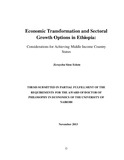| dc.description.abstract | This study examines the impact of openness, imported capital goods and liberalization induced sectoral total factor productivity on economy wide growth and the structural change process in Ethiopia. It also investigates the role of government in sustaining growth and structural change. We use sectoral growth accounting approach and vector autoregressive model that incorporates exogenous variables in order to calibrate the induced sectoral total factor productivity growths. We then introduce the calibrated sectoral total factor productivity in the dynamic computable general equilibrium model that uses the Social Accounting Matrix 2006. We also calibrate and introduce the elasticities of total factor productivity to change in spending composition in the dynamic computable general equilibrium model in order to capture the impact of shifting public resource towards productive sectors. The simulation results show that openness induced agricultural total factor productivity highly improves the welfare of households as compared to other growth scenarios. The liberalization induced total factor productivity in the service sector is also more efficacious in terms of enhancing the growth rate of the economy. The imported capital goods induced industrial total factor productivity is also better in fostering structural change of the economy. However, the broad-based growth option that combines the induced total factor productivity of all sectors enables the economy to achieve more sustainable growth, rapid structural change and welfare gain at the same time. Furthermore, the net effects of shifting public resources from administration to productive sectors positively influence growth rate, but have different implications on the structural change process. It is only the spending option of shifting public resources towards industry that generates a positive impact on the structural change process. The study therefore suggests the need to undertake a series of economic policy revisions and launch industrialization-centered broad-based growth strategies. This is also need for the government to be actively involved particularly in the area of manufacturing. We also recommend that foreign trade openness, service trade liberalization, and imported capital goods and services should receive special attention for driving sectoral total factor productivity. We also recommend that the government gives more emphasis to enhancing total factor productivity to complement factor accumulation in order to achieve perpetual growth and rapid economic transformation. | en_US |

